
Previously at the House of Hypertrophy, we saw the scientific literature strongly indicates a wide range of rep numbers are similarly effective for muscle hypertrophy, provided those reps are performed to or close to failure.
Per set, 6 to 35 reps are likely similar.
3-5 reps may be less efficient per set, so need extra sets to see similar hypertrophy to fewer sets with more reps.
Though these different rep numbers produce similar hypertrophy magnitudes, do they differ in the exact type of hypertrophy evoked?
It’s hypothesized certain rep ranges promote denser appearing muscles, while others produce puffy appearing muscles.
The idea of density and puffy muscles comes down to how muscle fibers grow.
There are 3 different ways a muscle fiber can technically grow.
Before detailing them, we must understand muscle fibers contain myofibrils. Myofibrils contain the contractile machinery that generates a muscle’s force. Growth of the myofibrils (via increases in numbers or size of pre-existing ones) will benefit strength as this means more contractile machinery to generate force.
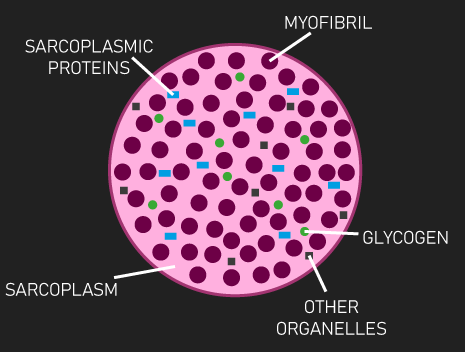
Aside from myofibrils, everything else in the muscle fiber can be considered the sarcoplasm. The sarcoplasm is largely water but also houses other components like glycogen, sarcoplasmic proteins, and non-contractile organelles. Of course, growth of the sarcoplasm alone does nothing for strength capacities.
One way muscle fibers grow is through the myofibrils (may note in video it can increase in size and number) and sarcoplasm growing at the same rate. This is called myofibrillar hypertrophy.

Another way is through the myofibrils growing at a faster rate than the sarcoplasm, this is called myofibrillar packing.

For this article, I’m going to merge together myofibrillar hypertrophy and myofibrillar packing and collectively refer to them under the term myofibrillar hypertrophy. The similarity between the two is they involve significant myofibril growth.
The third and final way muscle fibers can grow is through the sarcoplasm growing at a faster rate than the myofibrils, this is called sarcoplasmic hypertrophy.

It’s thought myofibrillar hypertrophy creates a denser muscle appearance, while sarcoplasmic hypertrophy creates a puffier appearance.
As we noted, it’s hypothesized certain rep ranges could target myofibrillar or sarcoplasmic hypertrophy more.
Some broadly believe lower reps produce myofibrillar hypertrophy, while higher reps produce sarcoplasmic hypertrophy
Others refer to comparisons between bodybuilders and weightlifters or powerlifters.
For example, the very popular book “the science and practice of strength training” suggests elite weightlifters see myofibrillar hypertrophy while bodybuilders see sarcoplasmic hypertrophy.

Of course, weightlifters (and powerlifters) tend to train with 5 or fewer reps, while bodybuilders with 8-15 reps.
In this article, we’ll address both arguments. How do muscle fiber adaptations compare between lower and higher reps, as well as bodybuilders and power athletes?
Table of Contents
Part I: Support for Rep Ranges Impacting Density vs Puffy Muscles
Certain scientific literature suggests rep ranges may influence the type of fiber hypertrophy evoked.
A 2015 study from the England compared muscle fiber characteristics from the vastus lateralis between 12 bodybuilders, 6 power athletes, and 14 untrained subjects.
The power athletes were American football players, track and field athletes, and weightlifters. They were broadly described as training “high intensity”.
The bodybuilder’s diaries revealed they mostly trained with 8-15 reps.
It was found the specific tension of the bodybuilder’s fibers was 62% lower than the power athletes, and 41% lower versus the untrained subjects.
The obvious question here is what on earth is specific tension?
It measures the force a muscle fiber can produce per unit of its cross-sectional area.
Remember the myofibrils in the muscle fiber are essentially what produce force, so specific tension fundamentally measures how much of a fiber is taken up by myofibrils.
So as the bodybuilders had lower specific tension versus the power athletes and control subjects, their muscle fibers contained lower myofibril amounts per cross-sectional area unit.
Indirectly, this implies their fibers contain more sarcoplasm, potentially suggesting they’ve experienced sarcoplasmic hypertrophy, whereas the power athletes more so myofibrillar hypertrophy.
Another 2008 study from Japan compared elite bodybuilders to elite weightlifters.
The bodybuilders had larger triceps cross-sectional areas and produced greater overall triceps isometric force. However, the ratio of triceps cross-sectional area to isometric triceps force was lower in the bodybuilders.

Put another way, per cross-sectional area unit, the bodybuilder’s triceps were weaker than the weightlifters.
Out of many possible explanations, one is the bodybuilder’s triceps just contain lower myofibril amounts and greater sarcoplasm space versus the weightlifters (in other words, they’ve experienced sarcoplasmic hypertrophy).
The researchers also found in both the bodybuilders and weightlifters, there was a correlation between triceps cross-sectional area and triceps isometric force.
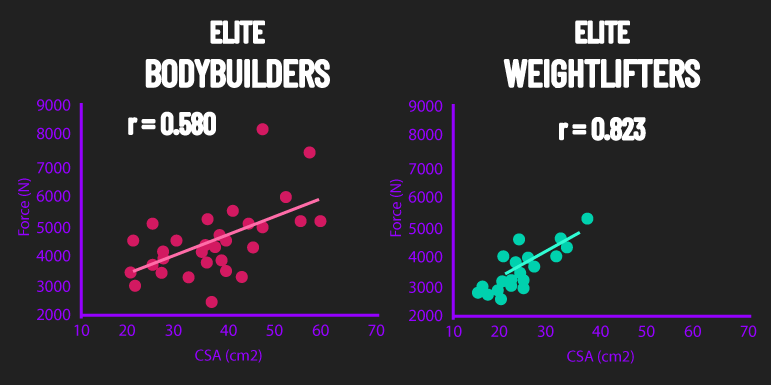
But the correlation was slightly stronger in the weightlifters. This stronger correlation may be because their triceps size contains a higher myofibril amount versus the bodybuilders (that is, they’ve experienced myofibrillar hypertrophy), creating the more precise relationship between their muscle size and strength.
We also have an array of other studies establishing in powerlifters specifically, there are strong relationships between measures of muscle mass and their strength on the bench press, squat, and deadlift (one, two, three, and four).
This would suggest the powerlifters muscle size presumably consists of a ton of myofibrils (perhaps attained via myofibrillar hypertrophy), causing the strong relationship to strength.
A final piece of evidence comes from a 2010 study from Canada, which compared 4 sets of repetitions to failure with either a 90% one-rep max load or 30% one-rep max load.
Of course, the 30% one-rep max load achieved way more repetitions across sets (24 vs 5 reps).
24 hours after the session, sarcoplasmic protein synthesis was greater for the 30% condition.
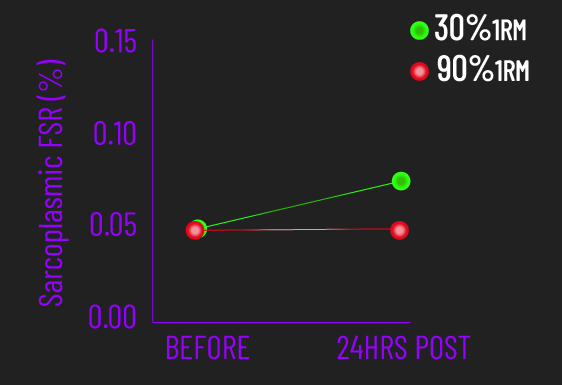
This very indirectly suggests the 30% one-rep max load may produce sarcoplasmic hypertrophy, as one thing that could cause disproportionate sarcoplasm growth is an increase in sarcoplasmic proteins that draw in additional water into the fiber.
So, the data we’ve overviewed suggests bodybuilding training may cause sarcoplasmic hypertrophy, while powerlifting or weightlifting may cause myofibrillar hypertrophy. Also, higher reps may produce sarcoplasmic hypertrophy over lower reps.
Before moving on, if you’re curious about creating an effective training program for muscle hypertrophy, our high quality partner Alpha Progression can help. It can generate a highly effective program for you, track your workouts live with in-built progression recommendations, provide graphs displaying your long term progress, and it has a massive exercise database with more than 550 exercises.
Click HERE (the link opens in a new tab) to get a free 2 week trial of the apps features. If you like it and go beyond, the link also gives you 20% off a subscription!
We never promote trash at the House of Hypertrophy, so rest assured the app is high quality. The reviews speak to this, 4.8 starts (based on more than 7,000 reviews) on Google play, and 4.9 stars in Apple’s store (based on nearly 400 ratings).
Part II: Limitations of the Overviewed Data
A number of notable limitations exist with the studies just assessed.
In the English study that found lower specific tension in bodybuilders and the Japanese study finding a lower ratio of triceps size to strength in bodybuilders, anabolic steroids could be a confounder.
Both studies involved high-level competitive bodybuilders. In fact, the English study noted that 9 of the 12 bodybuilders involved admitted to anabolic steroids usage.
This matters as it’s very possible independent of rep ranges and overall training, anabolic steroids may increase the occurrence of sarcoplasmic hypertrophy.
Unfortunately, I’m not aware of any science that can truly validate this.
But in the words of Greg Nuckols from stronger by science “A lot of people report gaining a lot of weight very quickly when they go on steroids (much more than could be explained by plain old myofibrillar hypertrophy) and losing it very quickly when they come off, likely indicating shifts in the amount of water they’re storing.”
Another limitation with the English and Japanese studies is causation cannot necessarily be drawn. Remember they just compared muscle fiber properties between bodybuilders and power athletes at one-time point.
They cannot truly suggest the bodybuilder’s training caused the sarcoplasmic hypertrophy signs.
It remains possible the bodybuilders in these studies, even way back before they began training, just had lower specific tension or lower size-to-strength ratios.
Finally, with the study finding greater sarcoplasmic protein synthesis 24 hours after training with a 30% versus a 90% one-rep max load, it’s just a short-term measurement.
In the absence of long-term measures, it cannot prove greater sarcoplasmic protein synthesis rates actually translate into measurable sarcoplasmic hypertrophy.
Furthermore, the study actually found that 4 hours after the training session, sarcoplasmic protein synthesis rates were greater for the 90% one-rep max condition.
So, it’s clear the current data suggesting rep ranges can modulate the type of muscle fiber growth experienced is notably limited.
Do we have any better quality evidence?
We do indeed, and this evidence may suggest rep ranges do not influence the type of muscle fiber growth experienced.
Part III: Data Opposing Rep Ranges Impact Density vs Puffy Muscles
We have an array of long-term studies directly finding myofibrillar hypertrophy, here’s a summary of them:

Plus these ones two:
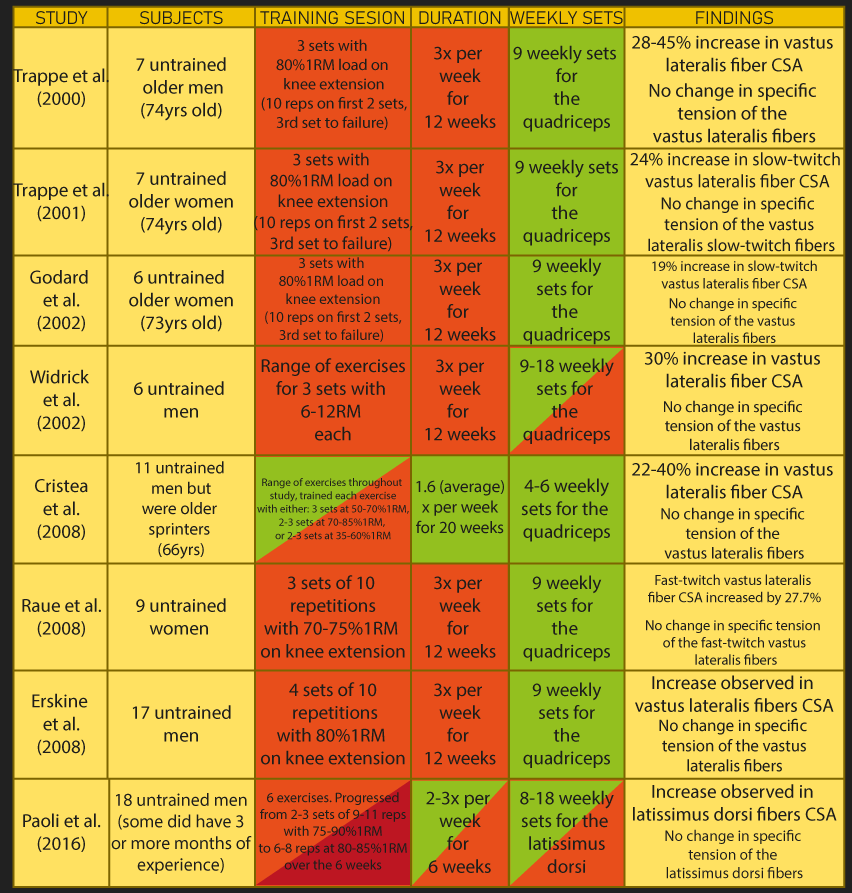
Notice how all of them involved training with largely 7-12 repetitions, these rep numbers are what bodybuilders commonly train.
Now, this doesn’t mean fewer reps don’t produce myofibrillar hypertrophy, it’s just no research has longitudinally explored this.
In any case, this is pretty strong evidence classic bodybuilding rep ranges do not preferentially produce sarcoplasmic hypertrophy.
What about higher rep numbers?
We have some interesting research here too.
Per set, 6 to 35 reps are probably similarly effective for muscle hypertrophy, provided those reps are performed to or close to failure.
Yet, strength gains (as measured by one-rep max on an exercise) always tend to be better with the lower rep numbers (and thus heavier loads).
For example, we’ve partly overviewed this 2015 study from New York in other articles, they had trained men perform 3 sets per exercise.
Hypertrophy outcomes were similar between training with 8-12 and 25-25 reps to failure per set.
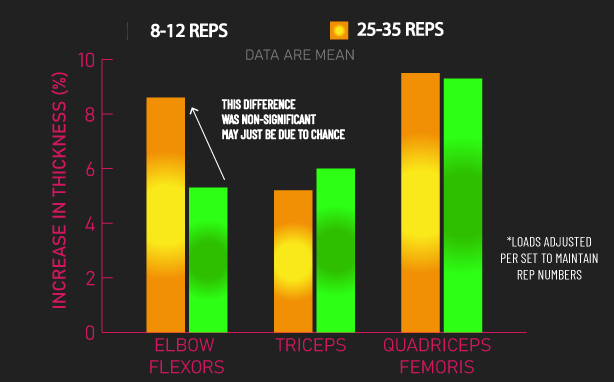
Yet, bench press and squat strength adaptations were greater for the 8-12 reps group.

Some may speculate that given 25-35 reps produced similar muscle size gains to 8-12 reps, but lower strength gains, the 25-35 reps may be not increasing myofibril amounts as much and hence must be producing sarcoplasmic hypertrophy.
The problem with this speculation, however, is it ignores other factors besides myofibril growth that may contribute to one-rep max strength.
A one-rep max is a skill.
There’s evidence with the same exercise, the precise technique and muscle recruitment pattern used differ between using light and heavier loads.
Thus, training with heavier loads would better develop your one-rep max skill and specialized neural adaptations compared to lighter loads.
Resultantly, in the New York study finding greater one-rep max strength gains with 8-12 vs 25-35 reps, part of this is likely attributable to 25-35 reps producing lower skill and specialized neural adaptations versus 8-12 reps.
So we cannot be certain the lower one-rep max strength gains with 25-25 reps have anything to do with sarcoplasmic hypertrophy.
As opposed to measuring one-rep max strength, testing isometric strength may be better in our context.
Isometric strength tests involve a much lower skill component, thus allowing us to better compare how increases in myofibril content compare between light and heavier load training.
When looking at the data that has done this, as summarized by a 2017 meta-analysis out of New York, isometric strength gains end up being similar between light and heavier load training.
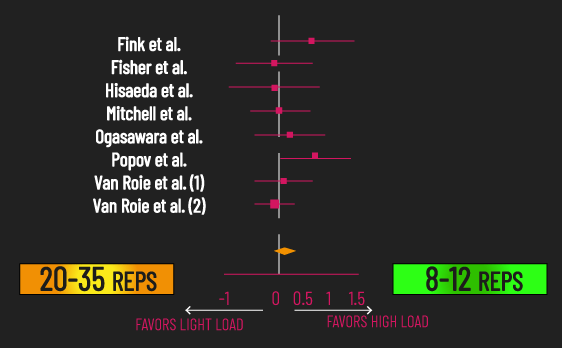
In this case, the heavier load training largely involved 8-12 repetitions to failure per set, while the lighter load training involved 20-35 repetitions to failure per set.
Now, I know many people don’t call 8-12 reps “heavy training”, but for our purposes here we’re just noting 8-12 reps is heavier training vs 20-35 reps to failure.
Nevertheless, this data would suggest that 20-35 reps are increasing myofibril content just as effectively to 8-12 reps.
Furthermore, recall many long-term studies find the 7-12 rep range is associated with myofibrillar hypertrophy, so extrapolating this and we can infer that 20-35 reps are also producing myofibrillar hypertrophy.
Summarizing this section, the stronger evidence outlined provides good grounds to infer different rep ranges may not produce different types of muscle fiber growths.
It appears a wide range of rep numbers can produce myofibrillar hypertrophy.
Part IV: So What Causes Sarcoplasmic Hypertrophy?
Here’s a table of all the current long-term studies finding sarcoplasmic hypertrophy:

Notice how 3 of the 5 used high volumes (defined as performing 21 or more weekly sets per muscle group). For example one of the studies by Macdougall involved training with a minimum of 27 sets for the triceps per week, another study involved training the quadriceps with 36 sets per week.
Inthe studies finding myofibrillar hypertrophy, notice how none used high volumes, rather low to moderate volumes.
Consequently, high volumes may be what drives sarcoplasmic hypertrophy.
Yet, I still advise caution in this conclusion, as only 3 studies find an association between high volumes and sarcoplasmic hypertrophy.
However, if high volumes do cause sarcoplasmic hypertrophy, this could explain the findings of earlier papers we assessed.
Remember the UK and Japanese studies finding bodybuilders showed potential signs of sarcoplasmic hypertrophy had notable limitations.
But it’s also possible those bodybuilders trained with higher volumes, explaining their sarcoplasmic hypertrophy indicators, rather than rep ranges per se.
In any event, future research is still needed to truly establish if higher volumes cause sarcoplasmic hypertrophy.
I also want to mention with the studies finding sarcoplasmic hypertrophy, except in one of them, the magnitudes of relative sarcoplasm expansion were largely not that much.
For example, in the Macdougall study involving at least 27 sets for the triceps per week, although the triceps fiber cross-sectional area increased by 23%, the relative space taken up by the myofibrils in the fibers decreased by 2% only. This indirectly indicates the sarcoplasm took up 2% more relative space.
I’m skeptical this small added relative space taken up by the sarcoplasm would manifest as a more puffy-looking muscle.
So in the real world and particularly for naturals, I don’t think sarcoplasmic hypertrophy is necessarily an aesthetic worry, the degree of sarcoplasm relative expansion may just be trivial.
But again, more research is certainly needed on sarcoplasmic hypertrophy overall, including examinations of the magnitudes of sarcoplasm expansion.
Part V: Summary
In summary, the scientific research one may use to suggest rep ranges preferentially cause myofibrillar or sarcoplasmic hypertrophy has very notable limitations.
Much stronger evidence suggests that rep ranges may not impact what muscle fiber growth is experienced. In fact, this data seems to suggest a wide range of rep numbers can produce myofibrillar hypertrophy.
Finally, some preliminary evidence indicates rather than rep ranges, higher volume training may be what causes sarcoplasmic hypertrophy.

